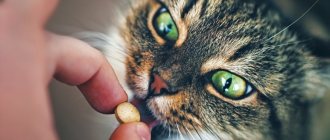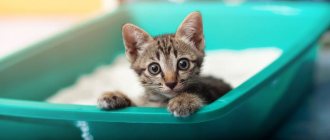Helping a cat give birth
“Only cats are born easily,” says a well-known proverb. Most often, cat birth occurs without complications. But there are situations when the help of a veterinarian or owner is required. In this case, a person should know how to help a cat during childbirth. This will help preserve the life and health of not only the expectant mother, but also the kittens.
In the article we will tell you how to help a cat during childbirth, the necessary preparation, the stages of labor, and what help may be required. You will also learn what difficulties may arise and what not to do.
Necessary preparation
Despite the fact that giving birth to a cat is a natural process, the owner of the animal will face considerable troubles. A cat living at home needs to create a special environment for the birth of offspring, provide veterinary care if necessary, “meet” new residents and make sure that they and the mustachioed mother have enough nutrition.
Arrangement of the “room” for childbirth
Arrangement of the place
If you do not prepare a place for the cat to give birth in time, she will find it herself. This is not always convenient, since a cat is a secretive animal, and it will hide with special care. Some cats leave home altogether and return, bringing kittens one at a time.
The ideal cat place would be a box or large basket with high walls. This could be a house from a pet store, a cardboard box, or even a cabinet drawer. It is important that it is sufficiently closed and spacious, but at the same time not too large - the expectant mother should feel safe and calmly feed the kittens.
Place the “maternity ward” away from drafts, bright light and doors: the place should be secluded and darkened. Place an old small mattress at the bottom of the box or drawer, then lay down an oilcloth, and place a regular baby diaper on top.
A quiet, cozy place where the cat will not be disturbed
Important! It is worth showing the cat the place in advance. If she still stubbornly seeks shelter, ignoring the prepared place, you should take her to the box when the birth process has already begun.
What materials, tools and medications may be needed
You need to thoroughly prepare for childbirth. To do this, you will need not only to arrange the place where the kittens will appear, but also to prepare some tools and materials that may be needed in case of complications that arise. In addition, you should make sure you have medications on hand.
For home birth you will need the following:
- telephone number of a veterinarian who can be contacted at any time;
- clean strips of fabric - you can tear a cotton sheet;
- disposable diapers; sterile threads (pre-soaked in alcohol); sterile scissors with blunt ends (can be boiled for 10-20 minutes);
- gloves;
- alcohol antiseptic or alcohol for hand treatment;
- container for placenta;
- warmer;
- baby bulb or pipette for suctioning mucus.
- healing ointments, for example, Levomikol, Vaseline, oxytocin, potassium gluconate.
You should prepare as much as possible for childbirth, so as not to be terrified of searching around the house for everything you need.
Prepare everything you need in advance for cat and kitten hygiene
Stages of pregnancy
Short-haired and hairless breeds bear kittens for 55-65 days, long-haired breeds - up to 75 days. Pregnancy time also depends on the number of babies in the womb. The more kittens, the faster the birth will occur. However, if there are 1-2 cubs in the litter, then they can be expected with some delay.
ATTENTION! Sometimes one meeting with a male is not enough. Conception can occur a third or subsequent times, so it is difficult to determine the exact date of pregnancy at home.
Let's trace the stages of pregnancy for clarity:
- By the 20th day, the cat’s nipples become rounded, turn pink, and may peel. The female moves less and avoids high surfaces. He prefers sleep to active games and eats heavily several times a day. The belly increases slightly, but in long-haired breeds this is not noticeable. When palpating, you can feel the developing fetus, but this should be done carefully, because hasty actions will harm both the cat and the baby.
- From day 40, the fetus begins to actively develop. Gradually, limbs, head, and tail are formed. Internal organs are being formed and the nervous system is developing. Subsequently, the fetus acquires features inherent in cats, and also acquires sparse hair. The cat gradually loses its appetite.
- By week 6, the fruits descend into the abdominal cavity and stretch out. The belly is noticeably rounded, but if there are only one or two kittens, the changes are practically invisible. The abdominal cavity increases noticeably and takes the shape of a pear.
- After the 50th day, future kittens move actively. If there are many of them, then there is not enough space for everyone. The cat is experiencing discomfort. The expectant mother experiences vaginal discharge and colostrum appears from the nipples. The pelvis relaxes, and any day now the cat will give birth. She restlessly walks around the apartment or lies for a long time in a pre-prepared nest.
Maine Coon, British, Persian and Sphynx cats often require owner intervention and, in rare cases, veterinary intervention.
What signs can you use to know that a cat is about to give birth?
If you know the day of mating, it will be easier to determine the approximate due date. A cat bears kittens for approximately 65-67 days.
The first signs of labor appear in a pregnant cat 7-10 days before. We wrote about such signs in our previous article. In order not to repeat ourselves, let's start with the main thing - the beginning of labor.
Cat before giving birth
So, most cats give birth on their own, and they do not require any outside help. But, if you are the owner of a purebred British, charismatic Scottish or cute Maine Coon cat, you, of course, will want to take part in this important process, and in order to support the family’s favorite in such a difficult moment for her, you must know how to help a cat give birth.
Tender care from a beloved owner will only benefit a cat giving birth. She will feel the support of a loved one and calm down a little.
Well, now about the main thing: how a cat’s labor begins, and what state it is in at this crucial moment:
- A few days before giving birth, the cat will choose a place in the house where it will be relatively dark and quiet. It is better to place a convenient box in this part of the living space, having previously covered the bottom with soft fabrics. Choose a box with small sides to make it easy for your cat to jump on. When the pet feels the beginning of the birth process, she will climb into the prepared box herself.
Cat before giving birth
- Some cats fundamentally do not want to give birth in a box with rags, and are looking for another comfortable place in the house. Make sure your pet doesn't go into the linen closet to give birth. Keep in mind that during the birth of kittens, the placenta and other secretions will come out of the cat’s genitals. Remove the cat from the closet and close the door tightly. Try to “convince” your pet to give birth in a prepared place. Gently lay it on soft cloths and stroke it on the belly or back.
- Before giving birth, the cat does not eat anything. There is no need to force her to eat. But be sure to place a bowl of clean drinking water next to the box.
- The cat moves around the house only to drink food or water, the rest of the time it lies and sleeps.
- Before giving birth, the cat will be restless; she may meow loudly and even scream. This is not at all surprising, because childbirth is a very complex and painful process not only for people, but also for animals.
The birth of the first kitten
- A caring owner may be nearby at this moment. Warm words and gentle stroking are enough to calm her down.
- While your cat is preparing to give birth, you should prepare to deliver the baby. This is necessary in case they occur with complications.
- A small amount of red or yellow mucus may be released.
- Reddening of the nipples, the beginning of colostrum secretion, this indicates the established process of lactation.
Setting up a nest
The birth of kittens is always a big stress for your pet. That is why it is very important to prepare the nest for birth in advance and try to accustom the animal to it. As a nest, you can use a spacious box that has a lid on top. So that the cat can easily get inside, it is necessary to cut a hole in the side. Do not place soft blankets on the bottom of the box. The best option is several layers of paper or baby diapers (they will most likely have to be thrown away).
The box should be placed in a warm, quiet and dark place where there are no drafts. Place a trash can, food and water in this room for your pet. And so the question: “How to help a giving birth cat?” Without taking you by surprise, we will tell you a little about the signs of pregnancy and the onset of labor in an animal.
Stages of birth in a cat
You will definitely notice that your cat's behavior on the day of delivery has changed dramatically. On the day of birth, a previously calm cat begins to constantly walk around the rooms, try on the nest an infinite number of times and often lick the genitals. What to do when a cat gives birth?
Rectal temperature drops by about 2 degrees. The cat's breathing quickens, and as the pain increases, she begins to purr and even scream. The animal's vagina swells and bloody or yellow discharge appears.
Second stage of labor in a cat
This is the first stage of labor and can last from 12 to 24 hours. You may not have to think about how to help your cat give birth to kittens, but it will be useful to support her morally (pat her belly and talk to her). Be close to your pet.
- The first stage of labor is accompanied by contractions mixed with pushing. Under the influence of pushing, the kittens move along the birth canal.
- The second stage of labor is the birth of kittens. First, amniotic fluid comes out, then part of the kitten appears. Kittens, like people, are born head first. If the presentation is different, the cat will need your help. It happens that a kitten moves its feet forward; this is not a pathology. –
After the birth of a kitten, the cat releases it from the amniotic sac, licks it, and chews the umbilical cord. After the cub begins to breathe and screams, she puts it to her chest. This is a normal birthing process for cats.
Licking a kitten after birth
- During the third stage of labor, the state of the cat's uterus becomes calm after the birth of each baby. Following the kitten, an afterbirth appears, which the cat eats. To prevent your cat from vomiting or diarrhea after giving birth, it is best not to let her eat more than two placentas. The quiet period of the uterus lasts about fifteen minutes, after which labor resumes.
Gamavit for obstetrics
This traditional medicine is recommended to be used to help cats during childbirth for several reasons.:
- It helps to avoid uterine rupture due to excessively large offspring;
- It prevents diseases such as endometritis and pyometra.
- Reduces the risk of birth and postpartum complications.
- Allows the animal to quickly return to normal after birth.
The product is used by injection - intravenous, subcutaneous and intramuscular. To speed up the absorption of the medicine into the blood and induce labor, the injection should be given under the shoulder blade. In agreement with the veterinarian, the drug can be given to the cat to drink. For an adult cat, the dosage of the drug for one injection can be from 1 to 1.5 ml.
© shutterstock
When a cat may need help
If events did not unfold according to the scenario described above, then your help is needed. How to help a cat give birth at home?
A) The cat is pushing, but the kittens are not coming out.
It is necessary to carefully insert a pipette lubricated with Levomekol into the vulva and make sure that the baby is not stuck in the birth canal. After this, we inject 1 ml of Gamavit into the withers and begin to stroke the cat’s belly in the direction of the fetal movement “towards the exit”.
The afterbirth should come out with the kitten
B) If you see that the kitten is stuck, then simply lubricate the paths with Vaseline.
C) The kitten was born, but the cat did not open its bladder - cut the bladder with sterile scissors, remove the kitten and clear its airways. After drying with a soft towel, apply it to the mother.
D) The cat has not chewed the umbilical cord - tie it with a 4 cm thread, cut it off and treat the break with an antiseptic.
E) The kitten came out unconscious - perform an impromptu heart massage: rub it with a towel, shake it lightly, clearing the respiratory system.
E) The cat is choking and convulsing - inject calcium gluconate (1 ml) intramuscularly.
It is not recommended to carry out the measures described above on your own; it is better if you know about them, but a veterinarian will carry them out.
If you see that the kitten is stuck, then lubricate the paths with Vaseline
Also, a cause for concern is the timing, which is very different from the standard - 2 months, or 60 days. If a cat gives birth prematurely, there is a high risk of stillbirth or death of the offspring after birth. The absence of births for more than 70 days may indicate a frozen pregnancy, when the kittens died inside the mother. In this case, you need to urgently take measures to save the cat.
Causes of problems
Taking a dip at home is quite easy. It doesn’t matter if it’s a village house or a city apartment. But in some cases, the pregnancy period has passed, and the cat still does not give birth, although all the signs are obvious. The kittens will continue to grow, taking away strength and energy. The larger the fetus, the more difficult the birth will be. They should not be tightened.
Let's list the main reasons why a cat is unable to go into labor on time:
- malposition;
- the kitten is too big;
- narrow pelvis;
- insufficient amount of lubricant;
- incomplete dilatation of the cervix;
- age of the cat;
- mechanical injury;
- inflammation of the genital organs;
- the cat is overweight;
- breed characteristics - dwarf, Himalayan;
- anatomical properties of the vaginal vault.
Weak labor activity stands out. There are two main types. The first is a slight tone of the uterus. It is caused by a lack of the hormone oxytocin. In rare cases, calcium. The second occurs when labor lasts more than a day, the cat has lost a lot of strength and can no longer push.
To avoid the problems described above, a pregnant cat is taken to a veterinarian before giving birth. He conducts examinations and makes recommendations if any of the listed anomalies are detected. In rare cases, hospital observation is required to prevent the death of a cat and its offspring. This could be a clinic in Moscow or a good provincial one.
What not to do during childbirth
Sometimes the owner of a mustachioed friend can harm the animal due to inexperience.
To prevent this from happening, take a close look at the list of things that are strictly forbidden to do when giving birth to a cat:
- Do not pull a newborn cat by the head or neck.
- It is also forbidden to pull too hard on just one paw.
- It is prohibited to use antiseptics that are intended for treating human wounds.
- Do not allow a giving birth cat to eat more than two placentas.
- It is prohibited to turn on bright lights in the maternity ward. Moreover, it should not be included in the first 2-3 weeks of a kitten’s life, as this can cause cataracts.
- In the first 2-3 hours, try not to pick up newborns. Leave them in the care of the mother: she will lick and warm the babies on her own.
Complications during childbirth
Of course, births in cats do not always go well. Sometimes unexpected complications happen.
If the kitten gets stuck during birth, do not allow the cat to bite through the bubble. In this position, the baby may suffocate. You can help the kitten: during the next contraction, gently pull him by the body. To improve patency, pre-lubricate the emerging part of the newborn’s body with Vaseline.
If a cat cannot give birth, she needs help
You may even have to urgently call a veterinarian for help. Such measures should be taken in the event of:
- long-lasting contractions, without the birth of babies;
- if the cat does not give birth for a long time, she experiences severe weakness, rapid heartbeat, body temperature above 39 degrees, loss of consciousness - urgently call a doctor at home;
- Bloody or purulent discharge with an unpleasant odor appears from the cat’s genitals.
The need to induce labor
Stimulation of labor is used in cases of late lambing or a prolonged interval between the birth of babies (more than an hour), when the pet cannot give birth on its own.
You need to wait some time. When 1-2 kittens are born, labor may subside and then reactivate (in some cases it can take up to a day). Labor can be stimulated by massaging the mammary glands and nipples. In extreme cases, it is possible to use oxytocin, a drug that promotes contractions of the uterine wall. It should be borne in mind that improper use of the product can cause the death of the mother and offspring.
What to do if the fruit is large?
How to help a cat give birth to a large kitten? Even if he moves head first, his shoulder area can prevent birth.
We fix the problem this way:
- After lubricating the vagina, insert your finger inside and try to feel the elbow bends of both paws of the kitten one by one.
- Grab each paw at the shoulder joint.
- Turn the baby from side to side, try to alternately stretch its paws forward.
- If the baby is in the lower part of the birth canal, force the pet to push. To do this, you need to stretch the vagina.
If the fruit is large, the cat needs help
What to do if a cat cannot give birth?
If the animal is unable to give birth on its own even under the influence of Oxytocin, it is necessary to immediately contact a veterinarian. The doctor may resort to a last resort option - a caesarean section. Many owners are afraid of surgery, but it is considered the safest method of treating fetuses without risking the life of the animal. The procedure is carried out in several stages:
- they use general anesthesia, during which the cat falls asleep and cannot move;
- the peritoneum and uterus are incised;
- the fruits are removed along with the amniotic sacs and placenta;
- suturing the uterus and abdominal wall;
- use an antiseptic to eliminate the risk of infection;
- waiting for the hypnotic effect to end.
Freeing the kitten from the amniotic sac
When the fetus is delivered along with the amniotic sac, it is recommended to apply the following rules:
- Do not pull on the umbilical cord, as this may cause a hernia.
- The umbilical cord is cut with sterile scissors with blunt ends 1 cm before the kitten's abdomen.
- The umbilical cord area is cauterized with iodine.
- If the cat does not lick the kitten, rupture the amniotic sac in the area of the kitten’s nose and suck out the fluid from the nose and mouth using an enema.
- They give the newborn to the cat so that she can lick it and apply it to the nipple.
- The placenta is counted, since each of them may not come out immediately after the kitten, but after some time.
Attention! It is extremely important to count the placenta, as if parts of it remain inside the uterus, this will lead to infection and possible death of the animal.
Newborn Sphynx kittens
When to call the vet
During childbirth, critical situations may arise that can only be resolved in a clinical setting. This:
- More than a day has passed since the first contractions;
- it is not possible to independently remove a stuck kitten from the birth canal;
- there are no precursors of the onset of labor, although more than 65-70 days of pregnancy have already passed;
- the cat has a high or, conversely, low body temperature;
- the animal does not strain or move, breathing is weak;
- contractions are strong, but the kitten does not appear;
- unpleasant-smelling contents mixed with pus and blood are released from the birth canal.
Caesarean section during childbirth











